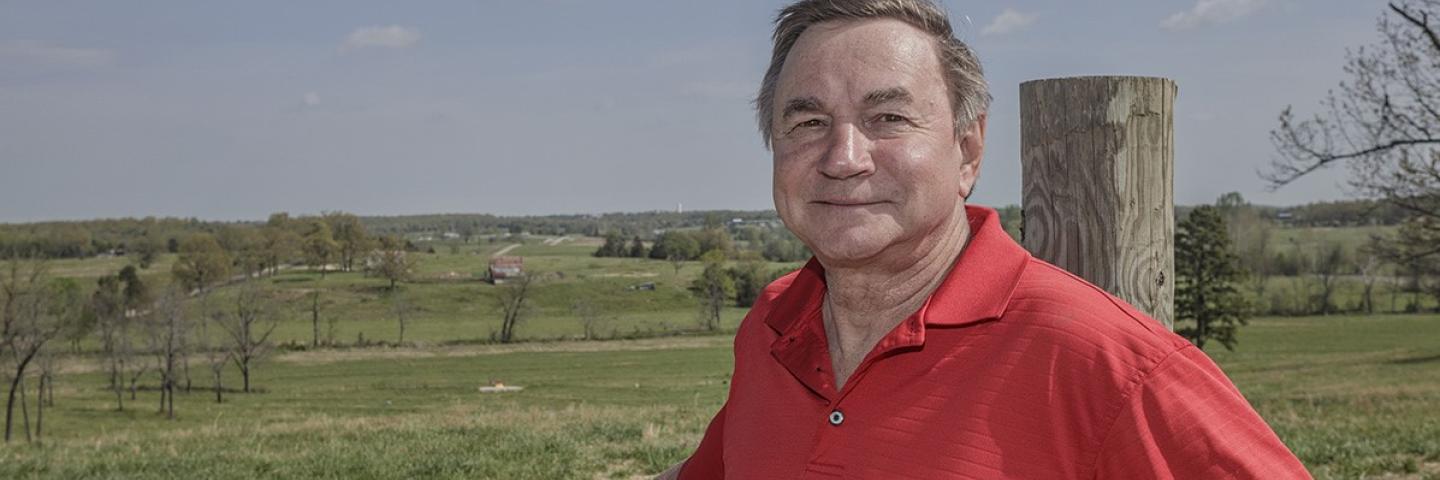Skeptical Izard County Farmer Amazed at Conservation Practice Success

Izard County rancher Bucksey Harmon. “As soon as I can, I’m going to do some practices on the other side of the road,” he said referring to the additional 250-acres he owns. “I’ve got so much more grass over here than there because of these practices.”
When Bucksey Harmon first heard of rotational grazing he was skeptical it would work on his
cattle farm.
“My neighbor started a rotational grazing program several years ago and was telling me the benefits and how much more pasture he now had,” Harmon said. “When driving by his farm, I could see how much more grass he had. I’d seen enough but was still skeptical, that even though it worked for him it might not work for me.”
Although apprehensive, the Izard County cattleman, visited the USDA Natural Resources Conservation Service (NRCS) Office in Melbourne, Ark., to see if rotational grazing would work on his farm.
“The staff helped me understand some of the things that didn’t make sense to me,” Harmon said. After the visit, he applied for funding consideration through the Strawberry River Watershed Mississippi River Basin Healthy Watersheds Initiative (MRBI).
The MRBI project is a voluntary program that provides financial and technical assistance to agricultural producers for addressing water quality concerns in the Little Strawberry River and Philadelphia Creek-Piney Fork watersheds in portions of Fulton and Izard counties. The project area covers 43,821 acres.
Harmon was selected for funding and enrolled 120 acres in an Environmental Quality Incentives Program (EQIP) contract for fencing, watering facilities, pipelines and other conservation practices to improve his pasture and water quality.
“Practices such as rotational grazing, watering facilities and spraying weeds allows more grass to grow,” said Monica Paskewitz, NRCS district conservation in Izard County. “The taller the grass the more filtration of runoff it provides.”
Harmon has noticed a difference. “I can tell after a rain my pasture is soaking up more water and less is running off … when the grass is short it just runs off,” he said. “I also don’t feed near as much which saves me money.”
The first year of rational grazing, Harmon said he was amazed at how much more pasture he had in the fall. His conservation plan called for six paddocks averaging about 20 acres each. “Once you get the cattle use to the system, every six days they’ll be standing there ready to go from field to field.”
Three watering tanks installed in the middle of the cross fencing keeps the cattle out of the ponds, helping the banks stay covered and decreasing sedimentation. With cattle only in the paddocks 4–6 days, they can’t eat all the forage and cause an erosion or overgrazing problem, according to Paskewitz. It also gives the land time to heal.
The watering tanks use city water and with their placement make the cattle graze more evenly across his pasture.
“I’ve seen my cows laying by the pond and get up to come to the tanks to get a drink instead of drinking out of the pond,” Harmon said. “By fencing the creek off, water quality in the creek has improved.”
One area of his farm was full of horse nettle and the forage quality was poor because of the weeds. But, thanks to spraying, he now has grass where he never had it before. “The spraying impressed me. It made such a believer of me I bought a 500-gallon sprayer,” he said. “If we don’t take care of our land and let it grow up in weeds and bushes, it doesn’t do us any good.”
Harmon said with these practices his cattle and land are in better shape. And, because of this, he’s looking forward to installing more NRCS conservation practices.
“As soon as I can, I’m going to do some practices on the other side of the road,” he said referring to the additional 250-acres he owns. “I’ve got so much more grass over here than there because of these practices.”
To learn more about NRCS programs, contact your local field office or visit https://go.usa.gov/xPCVY to find your local field office.

Bucksey Harmon, left, shows Izard County District Conservationist Monica Paskewitz the progress of his rotational grazing pasture.
 "I've seen my cows laying by the pond and get up to come to the tanks to get a drink instead of drinking out of the pond," Harmon said.
"I've seen my cows laying by the pond and get up to come to the tanks to get a drink instead of drinking out of the pond," Harmon said.

